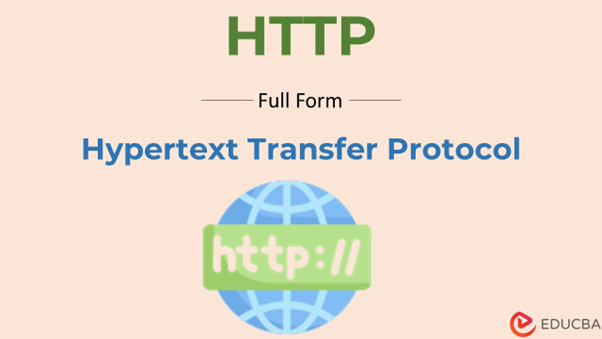Updated February 7, 2023
What is the Full Form of HTTP?
Hypertext Transfer Protocol is the Full Form of HTTP, recognized for giving web browsers and servers a common language to implement communication, also known as a set of guidelines for data transfer between computers. The transferred data is subsequently shared online. You use HTTP inadvertently every time you launch a web browser.
HTTP is a TCP/IP-based communication protocol that transports data on the World Wide Web, such as HTML files, jpeg images, database queries, and more. TCP 80 is the default port that standardizes the interaction of computers. The HTTP specification defines how clients assemble and send data to servers and how servers respond to those requests.
It is that type of protocol that responds to users’ requests and allows them to communicate with web resources by sending hypertext signals from clients to servers and vice versa.
History of HTTP
Tim Berners-Lee created HTTP between 1989 and 1991. Back when HTTP got invented, there were no headers or status codes in this rudimentary protocol for transferring HTML files from server to client with only one TCP connection. The client used to send a request, and the server used to respond. The process was simple and easy. This was till it grew into various versions throughout time.
Versions of HTTP
From the 20th Century to the 21st, HTTP has upgraded into several different versions. The latest version of HTTP had released in 2020. The various versions of HTTP are listed below:
#1 HTTP 1.0
The early version of HTTP merely permitted information retrieval from a server. However, when the Internet developed, it became inadequate. In 1996, around five years after version 0.9, HTTP version 1.0 was launched. HTTP 1.0 became significantly more reliable than HTTP 0.9. The HTTP header and the new HTTP methods are the primary catalysts for the protocol enhancements.
#2 HTTP 1.1
A year later, after the launch of HTTP 1.0, HTTP 1.1 was made public in 1997. The addition of various extensions makes HTTP 1.1 an improvement over HTTP 1.0. Each request/response paired in HTTP 1.0 necessitates creating a new connection. With HTTP 1.1, a single connection can process many requests. The HTTP 1.1 version included six methods in addition to ones already present in HTTP 1.0: Put, Patch, Delete, Connect, Trace, And Options.
#3 HTTP 2.0
About 18 years after the launch of HTTP, HTTP 2.0 was finally made public in 2015. HTTP 2.0 concentrated on enhancing protocol performance. HTTP 2.0 incorporated several enhancements to enrich connections and data transfer. Additionally, HTTP 2.0 replaced the earlier HTTP plain text versions with a binary protocol. HTTP 2.0 was a patch of improvements to address the issues and restrictions of earlier HTTP versions.
#4 HTTP 3.0
HTTP 3.0 is an Internet-Draft (IETF). Its first draft was released in 2020. The protocol used as the transport layer is the primary distinction between HTTP 2.0 and HTTP 3.0.
Benefits of HTTP
There are numerous benefits of HTTP. Some of them are listed below:
#1 The Addressing Model
- HTTP makes use of a sophisticated addressing technique.
- It assigns recognized names to IP addresses as it is easy to apprehend them on the World Wide Web.
- HTTP facilitates internet access when compared to the traditional technique of issuing an IP address.
#2 Versatility
- HTTP is exceedingly versatile and stable.
- When an application is required to upgrade to new capabilities, HTTP can download extensions or plugins and display the necessary data.
- Flash players and Acrobat readers are examples of this.
#3 Security
- Each file is downloaded separately and then ends in
- Only one component of a webpage is qualified to be sent.
#4 Latency
- The requests have lower latency due to no handshaking or mutual authentication.
- The HTTP mutual authentication process will start as soon as the connection is established.
- There will be no authentication mechanism in response to a request which will drastically minimize the connection latency.
#5 Availability
- When a website loads for the first time, all HTTP pages get saved in internet queues known as Page Caches.
- When the page reloads, the content loads swiftly.
- Because there are fewer concurrent connections, it uses less CPU and memory.
Conclusion
In conclusion, we understood the Full Form of HTTP, a user-friendly, scalable protocol. The client-server architecture and the ability to add headers enable HTTP to develop with the expanded Web capabilities. HTTP evolved from a text protocol that enabled web browsing in its early iterations to a binary protocol now accommodating a variety of systems. Thus, it is clear that HTTP is essential for the functioning of the modern World Wide Web.
The fundamental structure of messages has not changed since HTTP/1.0, even though HTTP/2 adds considerable complexity by embedding HTTP messages in frames to boost performance. The simplicity of the session flow makes it possible to study and troubleshoot it with just an HTTP message monitor for many other future versions.



